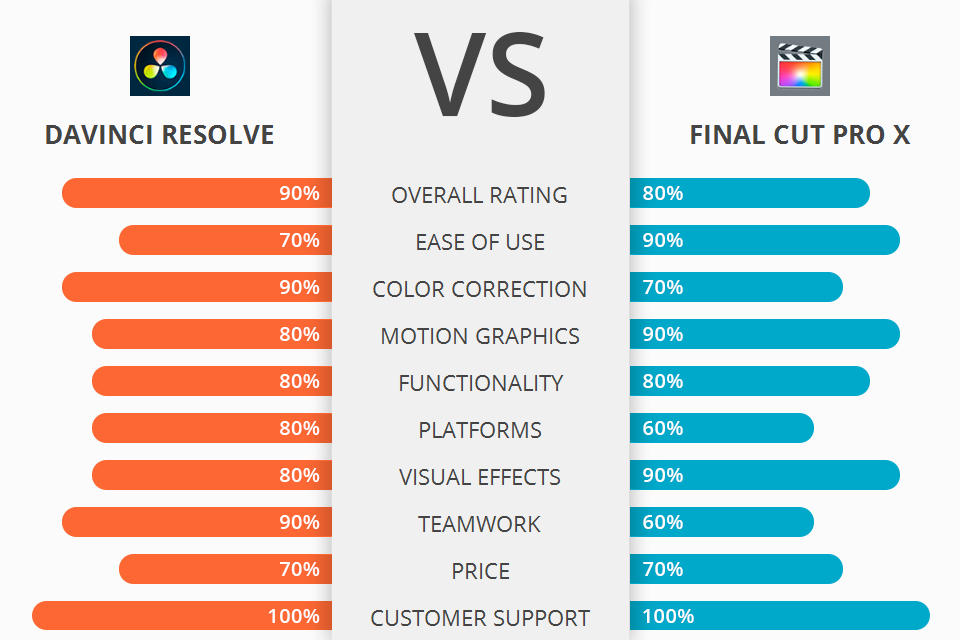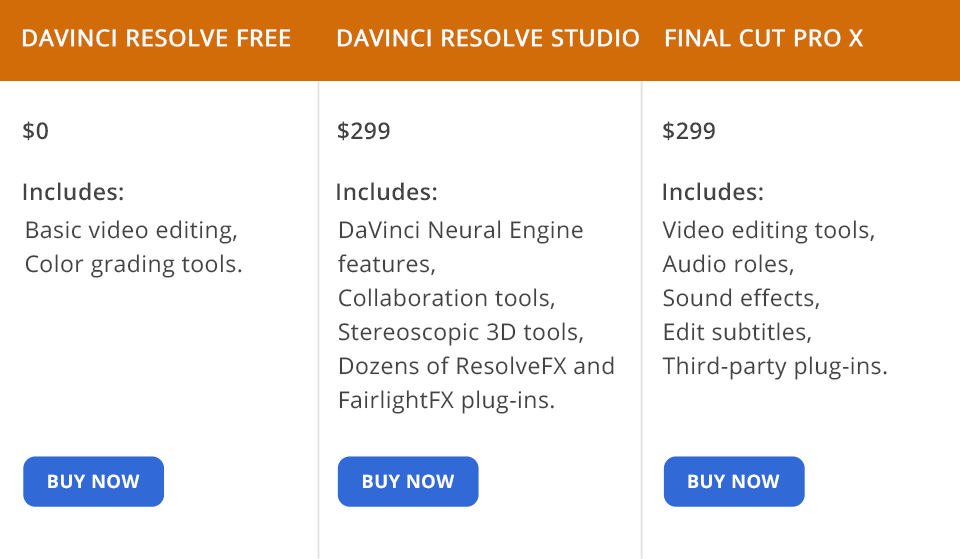DaVinci Resolve and Final Cut Pro differ in functions, tools, and interface.
DaVinci Resolve allows Windows and Mac users to edit video in a non-linear timeline, use a good color correction base, stunning mask, and text tracking with decent render speed.
Final Cut Pro X features a magnetic timeline and is aimed at Apple fans. Unfortunately, there isn’t Final Cut Pro for Windows. This editor is more suitable for beginners due to its user-friendly interface. Plus, you have plenty of built-in titles and motion graphics templates at your disposal.
What Is DaVinci Resolve?
DaVinci Resolve contains 4 modules: editing, color correction, sound, and visual effects. Using this video editor, you can edit videos from multiple cameras, add titles, transitions and video effects, work with 8K videos. Besides, you get AI tools, such as facial recognition, automatic color balancing and matching, and ResolveFX and FairlightFX plug-ins.
One of the main advantages of this free video editing software is its color correction and gradation capabilities. Users can select specific shades and colors and adjust them. You can improve an image as accurately as possible using the overlay and masking features. Moreover, with the LUT Browser, you can quickly find and use embedded color grading tools.
1/2

1/2

2/2
DaVinci Resolve: Strengths and Weaknesses
Professional color correction. In addition to such basic tools to adjust hue, saturation and brightness, you can work with color wheels and curves. You can also remove noise, preserving details, and track certain parts of an image as you move from one frame to another. You have ready-made filters, including a grainy film effect, flares, and more. You can even remove stains and dust from your videos.
Smart editing with AI tools. This feature may be a decisive point for those comparing DaVinci Resolve vs Final Cut Pro. DaVinci Resolve easily handles simple tasks like sorting videos or matching colors, thanks to AI tools such as speed warp motion estimation for retiming, auto color and color matching, a super scale for up-scaling footage, facial recognition. You can fill parts of objects with different content and combine frames with the same characters.
Convenient audio editor. The software offers a stunning range of sound editing tools such as a fully professional mixer, editing and automation options, multiple plug-in effects, equalizer, and dynamics. Fairlight has 13 sound effects, including plug-ins for sound restoration, effects for modeling various spaces, and tools for stabilization and noise reduction.
Built-in tools for applying visual effects. You can create a Hollywood-level movie by adding one of 250 visual effects. The software includes vector painting, 3D particle systems, rotoscopes and chroma keying, text animation and 3D titles, and more features. Thanks to Apple Metal support, multiple GPUs and CUDA acceleration, you can improve your clips even faster.
Cooperative video processing. DaVinci Resolve lets you work on a project with your colleagues. You can use markers to create, modify and add notes, manage your own cache files to optimize system performance, and set the level of access for team members. For example, in Read-Only mode, you can copy and paste assets out of it or review cuts without affecting other members of your team.
Working with complex animated graphics from scratch. This video editing software for Windows has built-in title and motion graphics templates, and you can easily customize them. Besides you can create keyframes and complex animations from scratch, focusing on ready-made guides.
Difficult interface. If you are a newbie to video editing and wonder which program - DaVinci Resolve vs Final Cut Pro X is better, you should consider the simplicity factor. Unfortunately, the interface of DaVinci Resolve can be complicated for beginners. So, they will have to go through several guides to understand the program.
What Is Final Cut Pro X?
Final Cut Pro X is a professional video editor from Apple. It features a magnetic timeline for quick video editing. You can move, trim and merge clips, synchronize them with sound. There is a built-in chroma key option, 2D and 3D titles for working with motion graphics. Comparing Final Cut Pro X vs DaVinci Resolve, we should note that this Apple software has more ready-made templates, so you can quickly enhance your videos with transitions, effects, or titles.
This video editor contains all the necessary tools to organize your clips. You can use libraries to create smart collections, tagging, and metadata for quick searches. There is Apple Xsan storage with file locking and the ability to export large projects as compressed proxy files for teamwork.
1/2

1/2

2/2
Final Cut Pro X: Strengths and Weaknesses
Automatic color correction. This automatic tool allows you to adjust color grading for the entire clip. If you want to change the settings manually, you can use integrated pro color correction tools, including a dedicated color inspector with color wheels, color curves, and hue/saturation curves. Keyframes and LUTs are also available. You can take advantage of the Final Cut Pro trial and test all these tools.
Solve audio problems by assigning audio roles. FCPX includes simpler audio tools if compared to advanced features of DaVinci Resolve. But the program has one unique instrument that the opponent doesn't have. This is the ability to assign audio roles. Thanks to this feature, you can separate music, dialogue, sound effects and more to avoid problems with audio. For the same purpose, developers added a tool for automatic sound correction and analysis. It improves the sound quality.
Simple Multicam video editing. The program allows you to automatically sync up to 64 angles of video with a variety of formats, sizes, and frame rates. You can view up to 16 camera angles simultaneously. Moreover, you can move, sync, crop, add effects or color gradation to separate views.
Powerful motion graphics tool. With FCPX, you can easily create 2D, 3D and 360° cinematic titles, smooth transitions and realistic effects in real-time. You get ready-made templates for adding titles and animation. Besides, you can create 3D models, adjust their position, rotation and scale using the keyframes editor. The latest version of the program comes with the Stroke Filter tool. It lets you outline the edges of a video, image, or text.
Over 200 built-in filters and effects. You can add smoke and sparkles to your videos using ready-made filters and effects. Moreover, it is possible to create your own effects and then watch the project in real-time. Also, you get access to replicators to create geometric patterns in 2D or 3D.
Improve frames shot in the air or without a tripod. Frame stabilization tools allow you to smooth out jagged camera movement or stabilize a shaky frame without time-consuming adjustments. The finished video will look like the one shot with a tripod. However, there will be still visible camera movement, including pan, tilt, and zoom.
Unconventional timeline-editing. You have to work with video on a magnetic scale. Its peculiarity is that when you delete a part of a clip in the middle, the whole video is automatically shifted.
DaVinci Resolve vs Final Cut Pro X: Price

DaVinci Resolve is free to use without time limits or overlaid watermarks. You can also buy an advanced version for $299. Comparing DaVinci Resolve Free vs Studio, we should note that the paid version includes AI tools, ResolveFX and FairlightFX plugins, stereoscopic 3D tools, and other functions for professional editing in addition to basic video editing instruments.
The full version of Final Cut Pro X costs $299. But you can choose the Final Cut Pro trial and test the software for free for 90 days.
DaVinci Resolve Free: $0. It contains basic video editing and color grading tools.
DaVinci Resolve Studio: $299. This version includes all free features plus DaVinci Neural Engine features, collaboration tools, stereoscopic 3D tools, dozens of ResolveFX and FairlightFX plug-ins, HDR gradation, film grain, blur and fog effects, and more.
Final Cut Pro X: $299. You can work with different camera angles, audio roles, sound effects, edit subtitles, and add third-party plug-ins.
DaVinci Resolve vs Final Cut Pro X - Who Wins?
It depends on your skill level and the platform you are working on.
Final Cut Pro X is a good option for Mac users, who are just starting to learn all the nuances of video editing. With its capabilities, you can quickly add transitions and effects to clips, and use multiple tracks. This video editor comes in handy when you need to collect clips or organize content as fast as possible.
DaVinci Resolve is designed for pro video editors, who are looking for advanced color grading tools. You can perform the full range of post-production manipulations thanks to the Fairlight and Fusion apps. You will also get AI tools for improving video and working with HDR footage, collaboration functions, and dozens of professional plug-ins.



